 |
Search the Site with

|
USS Independence (CV 62)
- formerly CVA 62 -- decommissioned -
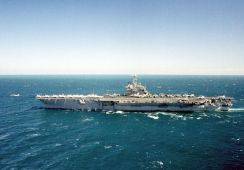 | 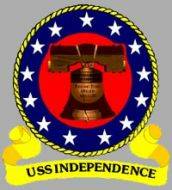 | 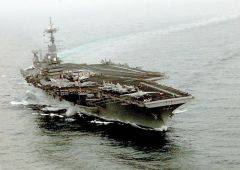 |
USS INDEPENDENCE was the fourth and last ship in the FORRESTAL - class of aircraft carriers. The fifth US Navy ship to bear the name, the INDEPENDENCE was commissioned as attack aircraft carrier CVA 62 and redesignated as multi-purpose aircraft carrier CV 62 on February 28, 1973. USS INDEPENDENCE was last homeported in Yokosuka, Japan, and is now laid-up at the Naval Inactive Ship Maintenance Facility at Bremerton, Wash. Because of the poor material condition at the time of her decommissioning, the Navy decided not to retain the INDEPENDENCE for future use as a museum. Initial plans were to sink INDEPENDENCE as a target. In December 2010, however, the Navy decided to scrap the INDEPENDENCE.
On March 11, 2017, the ex-USS INDEPENDENCE left the Puget Sound Naval Shipyard, Bremerton, Wash., under tow heading for the scrapyard in Brownsville, Tx. The tow took her around South America and was expected to take about two months until the carrier reached International Shipbreaking's facility. During her lay-up in Bremerton, she was extensively used as a parts hulk for the Navy's other aircraft carriers, leading to the decision to scrap her instead of offering her as a museum ship. The INDEPENDENCE was the last of the four FORRESTAL-class aircraft carriers to be scrapped. Her three sisterships have already been dismantled in Brownsville. Scrapping of INDEPENDENCE was completed on December 28, 2018.
| General Characteristics: | Keel Laid: July 1, 1955 |
| Launched: June 6, 1958 | |
| Commissioned: January 10, 1959 | |
| Decommissioned: September 30, 1998 | |
| Builder: New York Naval Shipyard, Brooklyn, N.Y. | |
| Propulsion system: eight boilers | |
| Rudders: two | |
| Propellers: four | |
| Blades on each Propeller: five | |
| Aircraft elevators: four | |
| Catapults: four | |
| Arresting gear cables: four | |
| Length, overall: 1,069 feet (326 meters) | |
| Flight Deck Width: 270 feet (82.3 meters) | |
| Beam: 129 feet (39.3 meters) | |
| Draft: 37,7 feet (11.3 meters) | |
| Displacement: approx. 80,000 tons full load | |
| Speed: 30+ knots | |
| Planes: approx. 85 | |
| Crew: Ship: approx. 2,700 Air Wing: 2,480 | |
| Armament: three Mk 29 NATO |
Crew List:
This section contains the names of sailors who served aboard USS INDEPENDENCE. It is no official listing but contains the names of sailors who submitted their information.
- Click here to view the list.
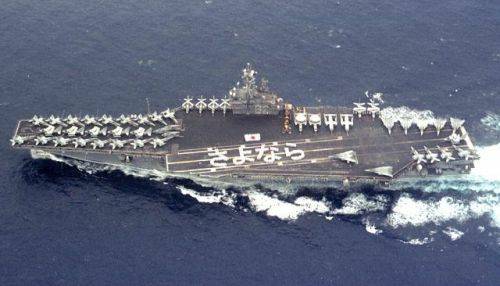
- Click here
to see which USS INDEPENDENCE memorabilia are currently for sale on ebay.
USS INDEPENDENCE Cruise Books and Pamphlets:
- Commissioning Cruise Book 1959
- Mediterranean Cruise Book 1960-61
- Mediterranean Cruise Book 1961
- Mediterranean Cruise Book 1962
- Mediterranean Cruise Book 1963-64
- Vietnam Cruise Book 1965
- Mediterranean Cruise Book 1966-67
- Mediterranean Cruise Book 1968-69
- Mediterranean Cruise Book 1970-71
- Mediterranean Cruise Book 1971-72
- Mediterranean Cruise Book 1973-74
- Mediterranean Cruise Book 1974-75
- NorLant / Mediterranean Cruise Book 1975-76
- Mediterranean Cruise Book 1977
- Mediterranean Cruise Book 1979
- Mediterranean Cruise Book 1980-81
- Mediterranean Cruise Book 1982
- Combat Cruise Book 1983-84
- Mediterranean and Indian Ocean Cruise Book 1984-85
- 30th Anniversary Cruise Book 1988-89
- WestPac Cruise Book 1990
- WestPac Cruise Book 1992
- 35th Anniversary Cruise Book 1993-94
- WestPac Cruise Book 1996
- Final Cruise Book 1998
- Decommissioning Pamphlet
History of USS INDEPENDENCE:
The USS INDEPENDENCE was launched by New York Navy Yard June 6, 1958; sponsored by Mrs. Thomas Gates, wife of the Secretary of the Navy; and commissioned January 10, 1959; Captain R. Y. McElroy in command.
One of the newest class of "supercarriers" at the time of her commissioning, INDEPENDENCE conducted shakedown training in the Caribbean and arrived her home port Norfolk, June 30, 1959. On August 25, during suitability trials on board INDEPENDENCE, an A3D Skywarrior, piloted by Lt. Cmdr. Ed Decker, took off at a gross weight of 84,000 pounds - the heaviest aircraft ever to take off from a carrier.
INDEPENDENCE operated off the Virginia Capes for the next year on training maneuvers, and departed August 4, 1960 for her first cruise to the Mediterranean. There, she added her great strength to the peace-keeping power of the 6th Fleet in that troubled region, remaining in the eastern Mediterranean until her return to Norfolk March 3, 1961. The remainder of the year was spent in training and readiness operations off the Atlantic coast.
INDEPENDENCE sailed April 19, 1962 for Sixth Fleet duty in support of President John F. Kennedy's firm stand on Berlin during a reoccurrence of stress in a critical area. She returned to Norfolk August 27, and sailed October 11 for the Caribbean Sea. Called on by President Kennedy on October 24, during the 1962 Cuban missile crisis, INDEPENDENCE provided a strong, visible reminder of U.S. determination and resolve while it acted as a key participant in the U.S. naval blockade of Cuba. She arrived off Puerto Rico in response to the presence of Soviet missiles in Cuba and took part in the quarantine operations which finally forced withdrawal of those missiles. She then returned to Norfolk November 25, for readiness exercises along the eastern seaboard, overhaul in the Norfolk Naval Shipyard, and refresher training out of Guantanamo Bay.
INDEPENDENCE departed Norfolk August 6, 1963 to take part in combined readiness exercises in the Bay of Biscay with sea-air units of the United Kingdom and France then entered the Mediterranean August 21, for further duty with the Sixth Fleet. Cruising throughout the Mediterranean, she gained much valuable experience during combined NATO exercises, including close air support to Turkish paratroops, reconnaissance, communications, and convoy strike support. President Makarios of Cyprus paid her a visit October 7, 1963, after which she joined in bilateral U.S.-Italian exercises in the Adriatic with Italian patrol torpedo boats, and U.S.-French exercises which pitted her aircraft against French interceptors and a surface action with French cruiser COLBERT (C 611). She returned to Norfolk March 4, l964.
Following training exercises, ranging north to New York and south to Mayport, Fla., INDEPENDENCE departed Norfolk September 8, 1964 for NATO Teamwork exercises in the Norwegian Sea and off the coast of France, thence to Gibraltar. She returned to Norfolk November 5, 1964 and entered the Norfolk Naval Shipyard for overhaul.
On May 10, 1965, INDEPENDENCE deployed for more than seven months, including 100 days in the South China Sea off the coast of Vietnam, the first Atlantic Fleet carrier to do so. She also was the fifth U.S. carrier operating off Vietnam. INDEPENDENCE and her embarked Air Wing 7 received the award of the Navy Unit Commendation for exceptionally meritorious service from June 5 to November 21, 1965. They participated in the first major series of coordinated strikes against vital enemy supply lines north of the Hanoi-Haiphong complex, successfully evading the first massive surface-to-air missile barrage in aviation history while attacking assigned targets, and executing, with daring and precision, the first successful attack on an enemy surface-to-air missile installation. The carrier launched more than 7,000 sorties in sustaining an exceptional pace of day and night strike operations against military and logistic supply facilities in North Vietnam. "The superior team spirit, courage, professional competence, and devotion to duty displayed by the officers and men of Independence and embarked Attack Carrier Air Wing Seven reflect great credit upon themselves and the United States Naval Service."
INDEPENDENCE returned to her homeport, Norfolk, Va. arriving December 13, 1965. During the first half of 1966, she operated off Norfolk, replenishing and training air groups. On May 4, 1966, she participated in Operation Strikex. The carrier departed Norfolk June 13, for European operations with the Sixth Fleet. INDEPENDENCE was involved with unit and NATO exercises from July into December. She then continued her Sixth Fleet deployment into 1967.
On September 25, 1970, word was received that Gamal Abdul Nasser, President of the United Arab Republic had died; an event that might plunge the entire Middle East into a crisis. INDEPENDENCE, along with USS JOHN F. KENNEDY (CV 67), USS SARATOGA (CV 60), and seven other U.S. Navy ships, were put on standby in case U.S. military protection was needed for the evacuation of U.S. citizens and as a counterbalance to the Soviet Union's Mediterranean fleet.
Pilots of VMA-142, -131, and -133 began qualification landings in A-4 Skyhawks aboard INDEPENDENCE on August 3, 1971. For the next three days, four active duty and 20 reserve pilots operated aboard the carrier - the first time that Marine Corps Air Reserve Squadrons qualified in carrier duty.
In May 1973, President Richard M. Nixon delivered his annual Armed Forces Day address from the decks of INDEPENDENCE. From October 8 to 13, 1973, Task Force 60.1 with INDEPENDENCE, Task Force 60.2 with USS FRANKLIN D. ROOSEVELT (CV 42), and Task Force 61/62 with USS GUADALCANAL (LPH 7) were alerted for possible evacuation contingencies in the Middle East. The ships were on alert as a result of the 1973 Yom Kippur war between Arab states and Israel. INDEPENDENCE operated off the island of Crete.
On June 20, 1979, Lt. Donna L. Spruill became the first Navy woman pilot to carrier qualify in a fixed-wing aircraft. Lt. Spruill piloted a C-1A Trader to an arrested landing aboard INDEPENDENCE.
In 1982, the ship provided critical support to the multinational peacekeeping force in Lebanon. In 1983, aircraft from the embarked air wing flew missions in support of Operation URGENT FURY, the action to liberate the Caribbean nation of Grenada. Returning to Lebanon that same year, the ship's air wing conducted air strikes against Syrian positions.
In June 1988, INDEPENDENCE Completed The Service Life Extension Program (SLEP) at the Philadelphia Naval Shipyard. It was fitting that the ship should be rejuvenated in Philadelphia, home of the Revolutionary War's "Liberty Bell," recognized worldwide as a symbol of liberty and freedom. Later in 1988 the ship transited around the tip of South America and arrived at her new homeport of San Diego, California.
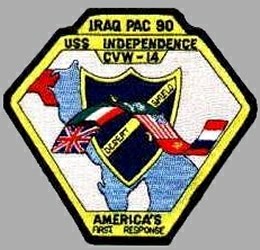 In August 1990 with Carrier Air Wing FOURTEEN embarked, INDEPENDENCE acted to deter Iraqi aggression during Operation DESERT SHIELD. She was the first carrier to enter the Arabian Gulf since 1974. The ship remained on station for more than 90 days and permanently reestablished a U.S. Naval presence and provided ready response capabilities in the region.
In August 1990 with Carrier Air Wing FOURTEEN embarked, INDEPENDENCE acted to deter Iraqi aggression during Operation DESERT SHIELD. She was the first carrier to enter the Arabian Gulf since 1974. The ship remained on station for more than 90 days and permanently reestablished a U.S. Naval presence and provided ready response capabilities in the region.
INDEPENDENCE changed homeports again on September 11, 1991 - this time to Yokosuka, Japan, embarking Carrier Air Wing FIVE and becoming the Navy's only forward deployed aircraft carrier and Flagship For Commander, Carrier Air Wing Five.
The ship again deployed to the Arabian Gulf in mid-1992 and started the SOUTHERN WATCH operation, a multinational mission to monitor Iraqi compliance with the U.N.-Established "no-fly zone" below the 32nd parallel.
In March 1994, the Team of INDEPENDENCE and Carrier Air Wing FIVE returned to Japan after successfully completing another deployment to the Arabian Gulf in support of Operation SOUTHERN WACTH.
INDY's next challenge took her to Hawaii for the exercise RIMPAC. She then entered drydock for her last scheduled Docking Ship's Restricted Availability period.
On June 30, 1995, the 36-year-old INDEPENDENCE became the oldest ship in the Navy's active fleet. With that distinction, INDY, the first aircraft carrier to hold the honor, is entitled to fly the Revolution-era First Navy Jack, commonly called the 'Don't Tread On Me" flag from her bow.
In August 1995, INDEPENDENCE and Carrier Air Wing FIVE team deployed to The Arabian Gulf for a third time in support of Operation SOUTHERN WATCH.
In March 1996, routine training was extended and INDY moved to the South China Sea to monitor Chinese missile exercises off the coast of Taiwan.
On April 18, 1996, President Clinton paid a visit to INDEPENDENCE as part of an official state visit to Japan. In June, INDEPENDENCE sailed to Hawaii to participate in the Rim of the Pacific (RIMPAC) '96 multinational exercise.
In November 1996, INDY returned to Japan after participating in the "ANNUALEX" exercise with our host-nation allies, the Japanese.
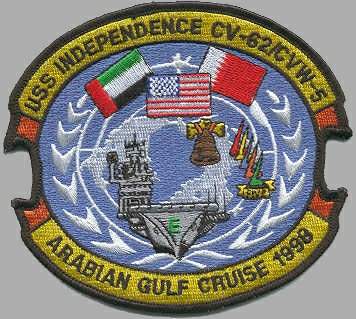 This past year, INDEPENDENCE made a four month "SOUTHERN SWING" deployment, covering several major exercises and seven ports of call. Included in these ports of call were two historic port visits. The first was on February 28 to the island territory of Guam. Indy was the first aircraft carrier to pull into Guam in 36 years.
This past year, INDEPENDENCE made a four month "SOUTHERN SWING" deployment, covering several major exercises and seven ports of call. Included in these ports of call were two historic port visits. The first was on February 28 to the island territory of Guam. Indy was the first aircraft carrier to pull into Guam in 36 years.
The second, two months later, was to Port Klang, Malaysia. INDY became the first aircraft carrier in the world to make a port visit to Malaysia.
Before sailing back to Yokosuka, Japan, INDEPENDENCE made her last port call of the deployment in May to Hong Kong. INDY’s port visit was the last U.S. Naval port visit to the territory before its revision to China on July 1, 1997.
On January 21, 1998, the Secretary of Defense, William Cohen spoke to the crew of USS INDEPENDENCE aboard the flight deck officially announcing the Independence's deployment to the Arabian Gulf. Cohen said INDEPENDENCE would relieve the USS NIMITZ (CVN 68) to keep the presence of America in the Gulf as a reminder to Saddam Hussein that he needs to comply with the United Nations resolutions. On January 23, 1998, the 39-year-old FORRESTAL class aircraft carrier got underway for the Arabian Gulf. In May INDY’s Battle Group was relieved by the USS JOHN C. STENNIS (CVN 74) Battle Group. On June 5, 1998, the carrier returned to Yokosuka, Japan, concluding its final deployment.
After a long and prestigious career, INDEPENDENCE was decommissioned at the Puget Sound Naval Shipyard in Bremerton, Wash., on September 30, 1998.
USS INDEPENDENCE Patch Gallery:
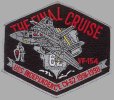 contributed by Foeke Keijzer | 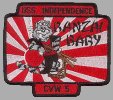 contributed by Foeke Keijzer | 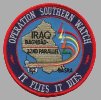 |  |  |
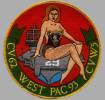 |  | Click here to view more USS INDEPENDENCE Patches. | ||
Accidents aboard USS INDEPENDENCE:
| Date | Where | Events |
|---|---|---|
| August 25, 1959 | off Norfolk, Va. | An F8U Crusader jet crashes into the rear of USS INDEPENDENCE killing one man and causing a fire. |
| January 11, 1960 | off the Florida coast | An arresting gear cable aboard USS INDEPENDENCE breaks as an aircraft lands, killing one. |
| April 27, 1961 | Caribbean Sea | USS INDEPENDENCE collides with USS DIAMOND HEAD (AE 19). INDY is not damaged but two departments of the DIAMOND HEAD suffer leaks and she's holed above the waterline. |
| December 13, 1965 | 220 miles southeast of Norfolk, Va. | An aircraft fuel tank ruptures on takeoff from the INDEPENDENCE starting a fire, injuring 15. |
| April 13, 1968 | off South Carolina | USS INDEPENDENCE collides with USS WRANGELL (AE 12) during an underway replenishment. Both ships are slightly damaged. |
| September 1969 | Northern Atlantic | During the launch of an aircraft, two fuel tanks broke off and caught fire. 48 Seconds later the fire could be extinguished by a MB-5 fire engine which stood next to the island when the fire started. |
| April 5, 1973 | Virginia Capes Area | USS INDEPENDENCE suffers a 45-minute fire in a catapult ventilation system which affects its operational readiness. |
| June 15, 1975 | Norfolk, Va. | A boiler flareback explosion damages two boilers and adjacent uptakes of USS INDEPENDENCE while moored at Norfolk, Va. |
| November 20, 1975 | North Sea | During a night underway replenishment, USS INDEPENDENCE collided with USS DENEBOLA (AF 56), suffering minor damage. |
| April 7, 1977 | 1,000 miles west of Rota, Spain | All nine ships in US Navy Task Group 21.2 including USS INDEPENDENCE suffer varying amounts of damage when they encounter a storm with 20-foot seas. Some INDEPENDENCE planes land at Lajes Air Base in the Azores. |
| April 20, 1977 | Tyrrhenian Sea | USS INDEPENDENCE and USS TRUCKEE (AO 147) collide during an underway replenishment when TRUCKEE loses steering control. |
| March 28, 1979 | Roosevelt Roads Area off Puerto Rico | USS INDEPENDENCE experiences a brief control room fire off Puerto Rico. Thirty people suffer from minor smoke inhalation. |
| August 15, 1981 | Norfolk Naval Shipyard, Va. | A fire aboard USS INDEPENDENCE while in overhaul damages the air operations and carrier control approach spaces. There are no injuries. |
| July 30, 1982 | Mediterranean Sea | An EA-6B assigned to VAQ-131 catches and separates an arresting cable during landing and subsequently goes off the port catapult into the water. All four crewmen ejected safely and landed almost on top of the plane which floated for several minutes. However, the pilot, LT Hubert Hodge, was killes when his shroud lines became entanged in the aircraft's fueling probe and he was dragged down when the plane sank. |
| September 8, 1983 | western Atlantic | At about 0930am, fires break out in catapults 3 and 4 receiver rooms, located just below the flight deck while INDEPENDENCE is underway during the second day of her Operational Readiness Evaluation (ORE). It takes approx. 3 hours to completely extinguish the fire and by dusk, the carrier is able to resume flight operations using her remaining two catapults. |
| April 3, 1997 | off Sydney, Australia | An |
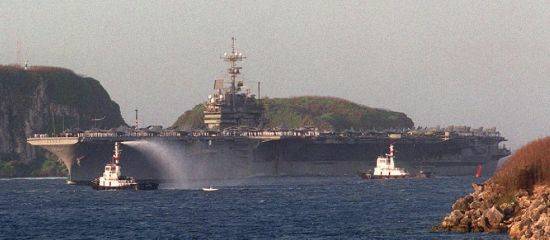
USS INDEPENDENCE Image Gallery:
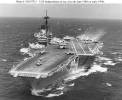 | 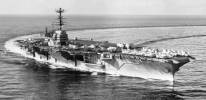 | 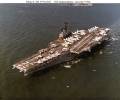 |  | |
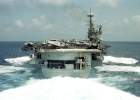 | 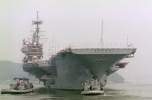 | 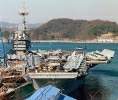 | 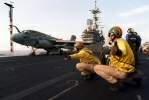 | 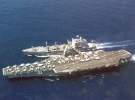 |
The photos below were taken by Les Burel (ETR3, USS INDEPENDENCE, OE Div., March '66 to March '68) and show operations aboard USS INDEPENDENCE in early 1967. At the time, the ship was returning home from a Mediterranean cruise.
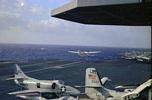 | 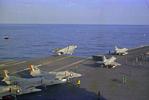 |
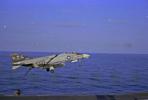 |
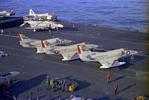 |
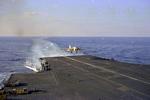 |
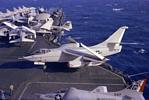 |
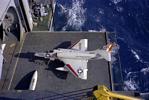 |
The scan below was contributed by Vinson Miller and shows the front page of one of INDY's newspapers. The below edition is from November 8, 1995.
 |
The photos below were taken by me and show the INDEPENDENCE laid-up at the Puget Sound Naval Shipyard, Bremerton, Wash., on March 14, 2010.
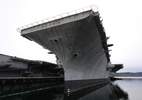 | 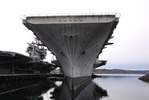 | 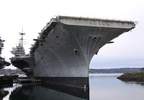 | Click here for more photos. | |
The photos below were taken by me and show the INDEPENDENCE laid-up at the Puget Sound Naval Shipyard, Bremerton, Wash., on May 12, 2012.
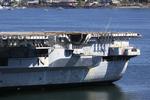 | 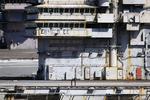 | 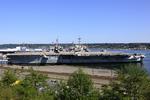 | 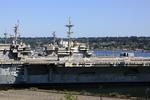 | 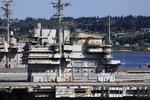 |
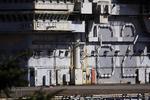 | 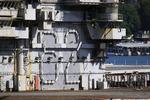 |
The photos below were taken by Michael Jenning and show the INDEPENDENCE laid-up at the Puget Sound Naval Shipyard, Bremerton, Wash., on April 17, 2016.
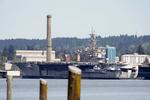 | 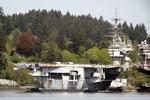 | 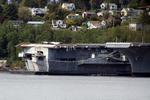 |  |
 Back to Carriers list.
Back to Carriers list.  Back to ships list.
Back to ships list.  Back to selection page.
Back to selection page.  Back to 1st page.
Back to 1st page.